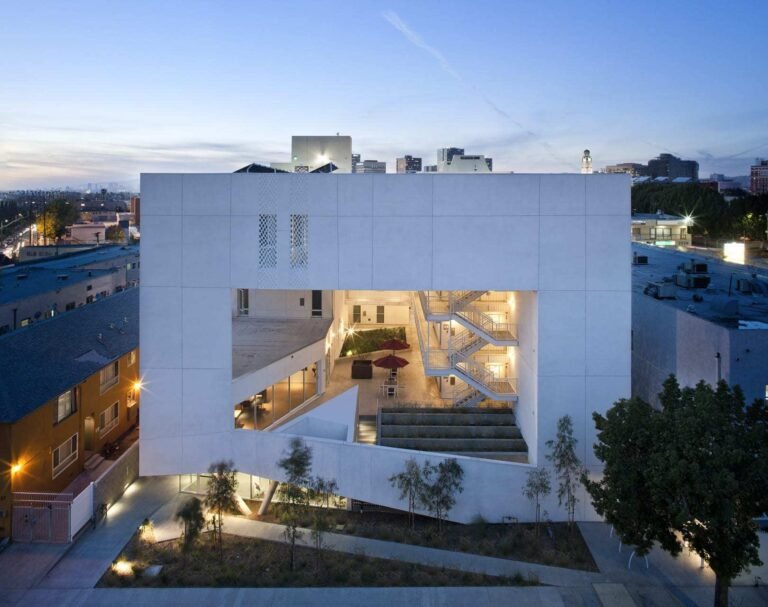Brutalist Interiors: Inside the Buildings of Belgrade
Brutalist Interiors: Inside the Buildings of Belgrade

A city of electric architectural diversity – Belgrade’s Modernist structures give the Serbian capital a unique character. The grey of Belgrade’s Brutalist concrete is one of the city’s architectural signatures, existing in both complex volumetric facades and monolithic rectilinear forms. But while a plethora of architectural appraisals has been conducted on the external qualities of brutalist structures in Belgrade and beyond, photographic documentation of Belgrade’s brutalist interiors is relatively rare – something that photographer Inês d’Orey has sought to change in her most recent exhibition.
Currently exhibiting at the Galeria das Salgadeiras in Lisbon, “Beograd Concrete” arose out of Inês d’Orey’s artist residency in Belgrade, where the photographer documented a diverse array of Belgrade’s Brutalist buildings – ranging from public buildings to offices and schools.
What is apparent in these images is a striking variety of interior design approaches – sometimes in a direct relationship with the exterior of the structure and sometimes in what seems like in direct contrast to it. Evidence of the latter is most clearly visible in the commanding Palace of Serbia in New Belgrade. The H-shaped structure consists of a façade constructed out of white marble, emphasizing the building’s linear form, broken up by a combination of thinner and wider window openings.
Related Article

One particular room comprehensively departs from the Palace of Serbia’s external ambiance – the Salon. A large room – measuring 40 meters by 20 meters – it features colorful frescoes and mosaics, a choice that seems to make the room even more monumental in scale. However, the centerpiece of the space is placed above these works of art – a sculptural chandelier that some have credited as the largest in the world. Consisting of over 4000 lights, the radial fixture is positioned with a glass dome, resulting in a geometric interplay of light captured in detail by d’Orey, who zooms in on complex patterns not typically associated with the Brutalist style.
But while Belgrade might feature buildings such as the Genex Tower, the Eastern City Gate apartments, and indeed, the Palace of Serbia, Brutalist icons can also be found in more small-scale structures. An elementary school named after Serbian teacher and writer Radoje Domanovic is modest by Brutalist standards, a two-story building that from an aerial vantage point, consists of three heptagonal polygons fused together. D’orey’s photograph of this school is taken in a classroom, featuring a solitary chair on a tiled floor.

Adjacent to the Radoje Domanovic Elementary School is the “TV building” – a Belgrade Brutalist landmark in the form of a rectilinear block lined with capsule-like windows. The elementary school features an interior design feature common in Brutalist landmarks – large windows, that in the case of the school’s heptagonal layout – enclose angular views of the surrounding context.

While a lot of brutalist buildings may be singularly characterized by the “weight” of their grey concrete, large, frame-like windows, as seen in the Barbican apartments, for instance, have frequently acted as a useful method for “lightening” spaces that would otherwise be overwhelmed by concrete’s coarse texture.
The other photographs in Inês d’Orey’s exhibition feature further documentation of Belgrade’s Brutalist interiors – some empty, some populated with a small amount of furniture, and some that illustrate rhythmic staircases.

In a monumental style similar to the Palace of Serbia, the Hotel Jugoslavija situated alongside the Danube River is also home to a dynamic interpretation of the Brutalist interior, albeit featuring the modern renovation and refurnishing of rooms, triggered by the striking of NATO bombs in 1999 and the hotel’s subsequent privatization. That, in a way, further layers its interiors. The spaces that have been left untouched from the era of Yugoslavia feature distinct mid-century interior design, with photographs from the 1980s showcasing extravagant furnishings.

A short drive from Hotel Jugoslavija, the multifunctional Sava Center is in view – the largest audience hall in the country. It’s an interesting building from the outside, featuring a sloping curtain-walled façade anchored by grey concrete. Opened in 1979, its interiors are wide-ranging in appearance, perhaps as a result of its use as a cultural, conference, and business center.

Amidst large yet intimate meeting rooms and upscale restaurants, the Sava Center also features an “industrial” motif reminiscent of Paris’ Centre Pompidou. This is most visible in the lobby, where the spacious open-plan area is enveloped by colored tubing in a ceiling that evokes the mechanical more than the grandiose.
In a city full of Brutalist sights, Belgrade’s brutalist interiors, extremely varied in execution and style, some abandoned and some still in everyday use, further illuminate how this architectural legacy exists in the contemporary context.
Inês d’Orey is a portugese artist. Born in Porto in 1977, she studied photography at the London College of Printing. Much of her artistic work focuses on the transformation of the heritage identity of the contemporary city, where the architectural object presents itself as a subject of memory, changing its meanings over time. Her main medium is photography, although she occasionally mixes it with installation and video.
Editor’s Note: This article was originally published on






